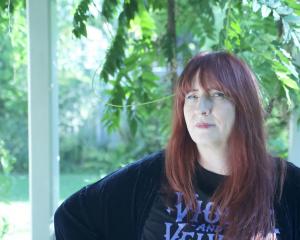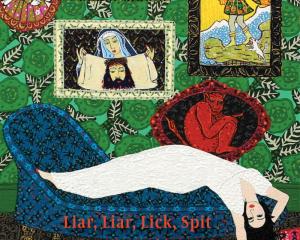Dunedin historian Erik Olssen's latest book captures Dunedin workers in an intimate light, while also celebrating the art of the photographer, writes Shane Gilchrist.
Roughly halfway through Dunedin historian Erik Olssen's latest book, Working Lives c.1900: A photographic essay, there is an illustration of perhaps two dozen men taking a quick break in Reid & Gray's foundry.
The photographic process has blurred the outlines of many of the men, suggesting ghostly or, at least, ancient activity has taken place.
Unintentional or otherwise, the depiction is fitting, given the foundry workers' methods had barely changed since the Bronze Age.

Working Lives provides a fascinating view into working-class life and the nature of work in New Zealand's first industrial suburbs, the images portraying the day-to-day circumstances in factories and shops as well as rituals among workers, such as staff picnics, fellow workers' weddings or even men resolving a dispute with a round of boxing.
''Work played a crucial part in the individual life, and the way work was organised fundamentally influenced how society developed,'' explains Prof Olssen, who spent more than 20 years as director of the multidisciplinary Caversham Project, New Zealand's largest study of urban social structure, out of which Working Lives stemmed.
''Our ideas about fairness and equality were shaped by this period. We are the products of this era,'' he says, adding the values and habits that evolved among the working men and women of the industrial areas in Dunedin came to permeate the city and the entire country.
Although Prof Olssen has completed books on similar subjects - 1995's Building the New World and last year's An Accidental Utopia - his latest presents a visceral sense of what working life was like in 19th-century New Zealand.
''This book is about working lives and, in particular, the places and organisations people worked in and the nature of the work they did,'' Prof Olssen said.
''While Building the New World did focus on certain occupations -carpenters, workshops employees - it mainly set out to show how skilled workers controlled the labour process.
"In Working Lives, I more or less take that as proven and try to convey an intimate sense of what the work entailed.
''Accidental Utopia was to be illustrated, but when the proofs arrived there were so many tables that I decided, with [Otago University Print's then managing editor] Wendy Harrex's agreement to omit the photographs.
''Wendy liked the captions I'd done so much, however, she suggested I do a photographic essay on work and workers.
''After An Accidental Utopia appeared I began searching for more photographs, in particular of work I'd previously dealt with briefly if at all.
"Hence here you'll find much more extensive discussions of navvying, bootmaking, pottery, brickmaking, even taxidermy, not to mention several women's occupations.
"White-collar and professional work is also now covered in more detail than I know of anywhere else.
''I've been thinking and writing about the relationship between work and society since writing about the goldfields. I've also been looking for photographs for that long.
"Indeed the ones from the Auckland Weekly News, which I found when researching the `Red Feds' in the late 1970s, set me off on this long journey to understand the work of skilled men.''
In his introduction to Working Lives, Prof Olssen writes: ''The impression of timelessness is the false beauty of the photograph'', referring to a misconception that the subjects of the photos were somehow socially, or at least vocationally, immobile.
However, in the 1890s and the 1900s, about 10% of men older than 21 had changed class a decade later and roughly the same proportion had also changed occupation.
''Each class, like each street, neighbourhood and suburb, was like a tram: always full, but full of different people,'' he writes.
The book is as much a celebration of the photographer's art as it is of working lives in Dunedin circa 1900.
It is also a reflection of what the photographer thought worthy of recording, Prof Olssen said.
Grand houses and squalid slums, notable people, the transformation of the wilderness, the rise of new cities and the growth of industry: all had their photographers.
So did many of the new society's leisure activities, he notes, adding that many subjects were deemed either uninteresting or unacceptable.
''Housework and the home interested nobody, although as the market for home appliances grew we find advertisements for coal ranges and coppers,'' Prof Olssen writes.
In his efforts to identify photographers and the context of their images, Prof Olssen also came to understand influences other than light might have been at play.
''Some of the shots used in Chapter 2 were taken for purposes of advertising, as we'd call it.
''Most of the shots of workers at work were taken for newspapers or journals, and doubtless reflected a general curiosity ...
"Some subjects were of no interest or were taboo, whereas others, like shots of the townscapes, were designed to illustrate progress or New Zealand's potential.''
Working Lives not only focuses on people; it also documents the dramatic transformation of land in Dunedin, particularly the south of a city that, in the 1870s, became the colony's leading commercial, financial and industrial capital.
''The townscapes certainly are fundamental to the transformation by work of a swamp into a modern industrial city free from the noxious features of Old World cities with their squalid industries, massive pollution, and human degradation.
''The establishment of these various industries are not only central in illustrating the skills and work involved, but also link to the larger belief of all workers, skilled and unskilled, that they were building a new world, a new civilisation.''
Fact file
Erik Olssen (ONZM, FRSNZ) taught at the University of Otago for 33 years and was professor of history from 1984 to 2001. He has published more than 70 articles and chapters on US and New Zealand history and written several books. For more than 20 years he directed the multidisciplinary Caversham Project, the country's largest investigation of urban social structure.
The book
Erik Olssen's Working Lives c.1900: A photographic essay, published by Otago University Press ($50), will be launched in the Hocken Library foyer, Dunedin, on Thursday, August 28, at 6pm.












